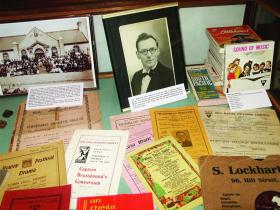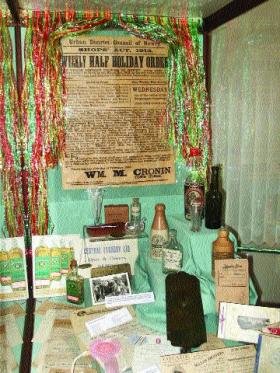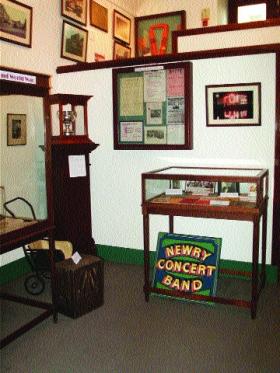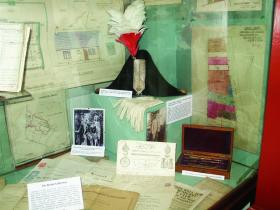Museum Eye
Published in Issue 3 (May/Jun 2005), Reviews, Volume 13
A selection of feis and drama programmes in the arts and culture section. (Newry and Mourne Museum)
Newry and Mourne Museum
Seán Hollywood Arts Centre, Bank Parade, Newry
(028) 30313182, museum@newryandmourne.gov.uk
by Tony Canavan
I have to declare a personal interest at the outset. In 1985 I was employed by the Newry and Mourne District Council to establish a museum in its arts centre. I subsequently remained until 1990 as the museum’s curator. In my time there my greatest complaint was lack of staff, resources and space. I am pleased to report that staffing is no longer such a problem as a curator, Noreen Cunningham, and an assistant, Emma Wilson, now ably look after the museum, while the amount of resources now spent on it is reflected in the quality of the exhibits. The problem of space (and establishing a strong identity) was exacerbated by the fact that the museum was added on as a wing to the already existing arts centre, but this will be solved in an exciting project to move the museum to the recently rediscovered Bagenal’s Castle on a hill overlooking the city. The discovery of the castle in the middle of McCann’s bakery is another story.
The proposed move, with the additional gallery space, has enabled the museum actively to look for new items for its collection. Its current exhibition, ‘A border town’s experience of the twentieth century’, is the result of the initial trawl. It is a preview of what will be the anchor exhibition in the new location and is on display in the small gallery that joins the museum to the arts centre. It consists of five panels and some display cases covering the themes of ‘The turn of the century’, ‘World War I and partition’, ‘World War II and the 1950s’, ‘The Troubles’, and ‘The path to peace’. The panels supply the information, photographs and reproductions of documents, while the objects in the case reflect Newry’s social and political history. There is an apron from the local freemasons’ lodge, an Irish National Forrester’s hat, and sashes from the Orange Order and the Hibernians. Another case has a copy of Ulster’s Solemn League and Covenant, a memorial card of Michael Collins, a cross made in Long Kesh and a Civil Rights leaflet. Social life is illustrated in a range of displays from a pair of docker’s boots at one end of the spectrum to a pair of bride’s silk shoes at the other.

Mementos of old industries—whiskey bottles from long-vanished distilleries.
Going through the door of the museum proper leads into its main gallery, which continues with the themes of the exhibition but also has a plethora of objects, photographs, maps and models that make the best use of a small space to display the city’s past in artefacts as diverse as a Singer machine for sewing shoes, a spinning wheel and the surveying tools of Major Reside, an important local figure who died recently, bequeathing his private collection to the museum. This room also contains mementos of old industries, such as whiskey bottles from long-vanished distilleries, the city’s cultural heritage in the form of drama festival programmes and much more. Pride of place must go to the display of a complete set of regalia of the Most Illustrious Order of St Patrick, the only complete set in any museum in Ireland. It was donated by Richard Needham MP, former minister in the Northern Ireland Office, whose ancestors once owned Newry and the surrounding land. More discreetly displayed is a side table claimed to have belonged to Admiral Nelson on his flagship Victory. However, apart from having the local masonic lodge named after him, this English hero has no direct connection with Newry.
Going on through this gallery you come to the gem in the museum’s collection, a uniquely restored eighteenth-century panelled room. Saved from a 1740s house demolished in the 1960s to make way for a road, the panelled room, a carved arch, a Venetian-style window and an ornate doorway (also in the museum) are all that is left of the city’s days of glory. The room itself is furnished in appropriate style and even has an eighteenth-century clock that was made in Newry. It also doubles as the research room, where, under the watchful eye of the curator or her assistant, historians may peruse the museum’s archive collection.
The final gallery is mainly devoted to the Bagenal and Needham dynasties, the Anglo-Irish gentry who played a prominent role in local and national history and were once lords of Newry and Mourne. There is a portrait of Nicholas Bagenal, killed at the Battle of the Yellow Ford in 1598, above two dress swords from the same period. Similar mementos of the Needhams also adorn the room. One other interesting feature in this gallery is a display on archaeology, which has a sand box and small trowel with which the visitor can dig for buried objects.
At present Newry museum does not have a lot of space, but what is does have is devoted to the display of artefacts and information. There are no hi-tech tools in the museum, which gives it a cosy old-fashioned feel (expect all that to change in the new site). Despite its limitations, it does an excellent job in conveying the history of the city. Visitors clearly enjoy it, if their comments are anything to go by, and one in particular sums up the Newry museum experience: ‘a grand walk through time’.

A general view of one of the galleries.
Tony Canavan is a former Museum Officer of Newry and Mourne District Council.

The Major Reside collection. (Newry and Mourne Museum)
















